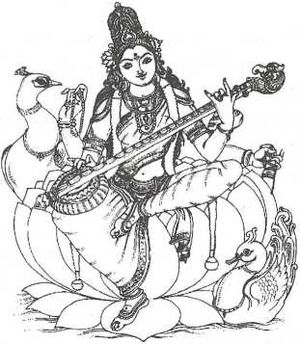Sarasvatī
By Swami Harshananda
Sarasvatī literally means ‘the flowing one’.
Sarasvatī is the Śakti, the power and the consort of Brahmā the creator. Hence she is the pro-creator, the mother, of the entire creation. Literally Sarasvatī means ‘the flowing one’.
Sarasvatī, as per Rgveda[edit]
In the Rgveda, she represents a river and the deity presiding over it. Hence, she is connected with fertility and purification. Here are some of the names used to describe her:
- Sāradā - giver of essence
- Vāgīśvarī - mistress of speech
- Brāhmī - wife of Brahmā
- Mahāvidyā - knowledge supreme
- Etc.
Sarasvatī, Mythologically[edit]
It is obvious that the concept of Sarasvatī developed by the later mythological literature is already here. The ‘flowing one’ can represent speech also if taken in an allegorical sense. Hence Sarasvatī represents power and intelligence from which organized creation proceeds. She is considered as the personification of all knowledge viz.:
- Arts
- Sciences
- Crafts
- Skills
Sarasvatī, As per Īśāvāsya Upaniṣad[edit]
As the īśāvāsya Upaniṣad[1] puts it, we transcend hunger and thirst through the secular sciences and then only we can obtain immortality through the spiritual sciences. It is to teach this great truth to us that Mother Sarasvati has chosen the two carrier vehicles, the swan and the peacock.
Iconographic Representation of Sarasvatī[edit]
Knowledge is the antithesis of the darkness of ignorance. Hence she is depicted as pure white in color. Since she is the representation of all sciences, arts, crafts and skills she has to be extraordinarily beautiful and graceful. Clad in a spotless white apparel and seated on a lotus seat, she holds in her four hands the following:
Though these are most common, there are several variations. Some of the other objects shown are:
Occasionally she is shown with five faces or with eight hands. Even three eyes or blue neck are not uncommon in her case. In this case, she is the Mahāsarasvatī aspect of Durgā or Pārvatī. Though no separate carrier vehicle is mentioned, haṅsa or swan, the vehicle of Brahmā-her spouse, is usually associated with her also. In popular mythological literature and pictures, a peacock is also shown as her carrier vehicle.
Symbolical Representation of Sarasvatī[edit]
Symbolically she can be represented as:
- Being the consort of Brahmā the creator, she represents his power and intelligence without which organized creation is impossible.
- To show that this intelligent power is stupendous and absolutely pure, she is pictured as white and dazzling.
- The four arms show her unimpeded power in all directions or her all-pervasiveness.
- Being the goddess of learning, Sarasvatī is shown holding a book in her left hand. The book represents all areas of secular sciences.
- Mere intellectual learning, without a heart tempered by higher feelings, sentiments and emotions, is as dry as saw-dust. So she holds a vīṇā (lute) on which she actually plays, to show the need for the cultivation of fine-arts.
- She holds akṣamālā[2] in the right hand. This symbolizes all spiritual sciences or yoga including tapas,[3] meditation and japa.[4]
- By holding the book in the left hand and the rosary in the right hand she is teaches us that spiritual sciences are more important than secular sciences.
- The peacock with its beautiful plumage stands for this world in all its glory. Since the attractions of the world lead the spiritual aspirant astray, the peacock can actually symbolize avidyā.[5]
- The swan, which is supposed to possess the peculiar power of separating milk from water, stands for viveka[6] and hence for vidyā.[7]
- Though it is true that vidyā or parāvidyā[8] alone can give us mokṣa,[9] avidyā signifying secular knowledge, the sciences and arts of the world, need not be and should not be neglected.
References[edit]
- The Concise Encyclopedia of Hinduism, Swami Harshananda, Ram Krishna Math, Bangalore

